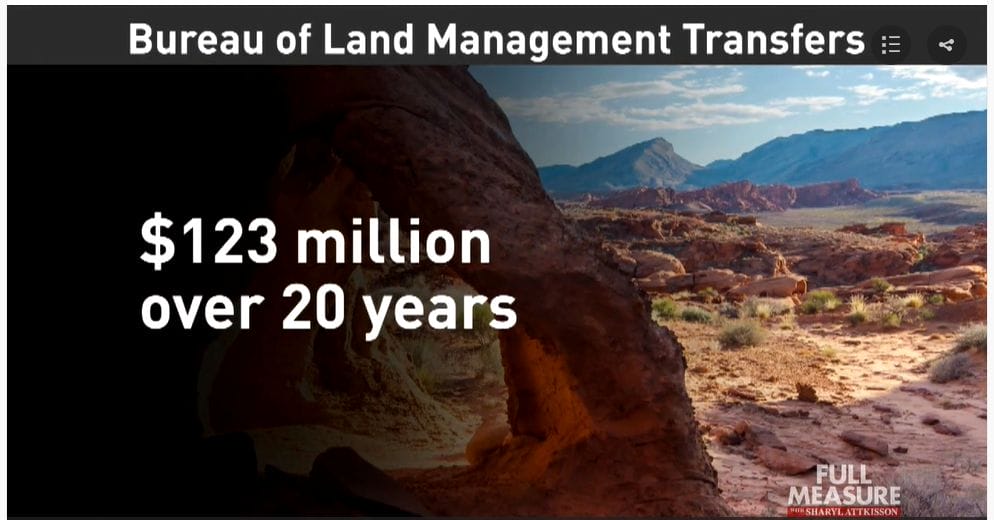Before troubles like riots, coronavirus and lockdowns triggered an exodus from America’s big cities, there was already a push to move some of our federal force out of Washington DC. Quietly, without much fanfare, federal agencies have been reassigning thousands of positions to far flung towns to decentralize power and save taxpayer millions. But the idea isn’t without detractors.
Last summer, when the nation’s attention was on the election and coronavirus the federal Bureau of Land Management was finalizing the move of its headquarters from Washington D.C to nearly 2,000 miles away to the small western city of Grand Junction, Colorado, near the spectacular Great Basin National Park.
Sharyl: So several hundred people have moved?
Casey Hammond: Several hundred positions have been moved.
During the move, Casey Hammond had oversight of the Department of Interior’s Bureau of Land Management which manages vast public land used for oil and gas development and recreation.
Hammond: So we looked at the Bureau of Land Management and found that more than 50% of the senior leadership was actually here in Washington, D.C. When the other 97% of the employees were out West. And the vast majority of our 245 million acres are also out West. So we had a disconnect between Washington, D.C., and the field.
40 key leaders at the high-priced Washington DC offices moved to the new Grand Junction headquarters and 222 of 550 other positions transferred to Montana, Idaho, Nevada, Utah, and New Mexico.
President Donald Trump (Feb 21, 2020): And we are taking the Bureau of Land Management out of Washington, D.C. We’ve just done it because we believe that the people who manage the lands of the great American West should live right here in the great American West.
Hammond: Our current headquarters space on M Street, in Washington, D.C., is around $50 a square foot. We can go to a place like Grand Junction and pay approximately half of that.
All told, it’s estimated the transfer will save $123 million over 20 years. The government has also relocated two parts of the Agriculture Department from Washington D.C. to Kansas City for a reported savings of $300 million over 15 years. The big moves were triggered by a little-noticed executive order President Trump signed in March 2017: “Comprehensive Plan for Reorganizing the Executive Branch” to improve efficiency, effectiveness, and accountability.
The history of Washington DC as the central point for federal agencies dates back to our beginning. But Professor David Fontana, who studies the concept at The George Washington University, wonders if DC hasn’t gotten too big for its own britches.
David Fontana: As Washington became wealthier and more demographically narrow, I think it becomes harder and harder for people in Washington to really hear what the rest of the country is saying.
I think you’re seeing that Washington, not just the district, but even the Washington metropolitan areas are narrower, narrower slice of America than it has been. I think that’s a real problem for a democracy.
Sharyl: Has there been a movement and has it been based in one political party or the other, to try to decentralize Washington DC, in essence?
Fontana: I think the idea has gotten more traction recently across both political parties. It’s something that Ro Khanna, the pretty liberal Congressman from California supported, Tim Ryan in the middle, and some of the tea party Republicans on the right.
But moving out of DC isn’t without controversy. Some Democrats fought the Bureau of Land Management’s or BLM’s move to Grand Junction, attacking the idea at a March hearing.
Rep. Deb Haaland (D-N.M.), March 10, 2020: Under the guise of putting staff closer to the communities it serves, the administration has done its best to dismantle the Bureau of Land Management.
Opponents claim the move wasn’t properly planned or justified. But they were unable to cut funding to stop it.
Before the Bureau of Land Management and the Agriculture Department other agencies had already shifted some of their workforce away from the nation’s capitol.
The FBI moved the Criminal Justice Information Services Center to Clarksburg, WV.
Customs and Border Protection built a giant Office of Training and Development with 200 federal employees, also in West Virginia.
Robert Perez: And so we’ve built over the course of the last 15 years, a real state-of-the-art advanced training center. Just 75 miles out of D.C. over in Harper’s Ferry, West Virginia.
Robert Perez is Deputy Commissioner for Customs and Border Protection.
Perez: In our case with our advanced training center A 220 plus acre campus, putting that in any large city, as opposed to a more rural area or a suburban area, clearly is going to be a major cost savings for us.
Some are pushing to go much further. Senator Marsha Blackburn proposed a law to move 90 percent of the positions in 10 executive departments from Washington D.C. to economically distressed regions.
Sharyl: Do you have any idea how much money that would save?
Sen. Marsha Blackburn (R-TN): Yes, you’re looking at a $300 million over the first 10 years.
Sharyl: Because real estate is less than the cost of living?
Sen. Blackburn: Real estate is less and even when you factor in moving, you’re still going to have substantial savings. Salaries are going to be less what the positions pay would be more equal to what jobs in that area pay. So it would be a good standard of living and we think this is a win-win.
That may be— but Blackburn’s proposal so far isn’t going anywhere. And if President Trump accelerated the tempo of decentralizing the federal workforce the pace may slow now that he’s moved out of DC.
Sharyl: I know you can’t read the future but if you’re looking at the tea leaves, what would you say?
David Fontana: My hope is that the current moment liberates people to work in lots of different places. If they work in lots of different places, they work could work for the federal government in lots of different places.
Sharyl (on-camera): Believe it or not there is no agreement on exactly how many federal agencies and sub-agencies exist, by one count there are well over 400.
https://fullmeasure.news/news/government-accountability/out-of-dc




Apart from saving money, I don’t know if this is a good thing or not? Is it?
While I need to study this writing here is the first thought that came to mind.
“Liberals moving into relatively conservative areas to dilute the conservative”.
” … dilute the conservative vote”.
“decentralize”?
You’re kidding, right?
Who signs their paychecks?
WHO APPROVES OF THEIR PROMOTIONS?
WHO MANAGES THEIR PENSIONS?
Those are HQ or staff functions. Let the HQ or staff management people travel out to subsidiary or field locations. Many decntralized businesses or industries do this now..
Interesting. Something like this could be used to revitalize small towns that have been dying. It would cause internet infrastructure upgrades in those areas that would spur additional private company moves.
As much as I’d like the GOV’T to keep a lid on their costs (instead of wasting taxpayer money) I REALLY don’t want them coming to my backyard! They suddenly realized that building rents in DC are too high, please, stop wasting the taxpayer’s money. So instead of trying to rein in their costs they’re going to move to less expensive states. UGH!! Tell them to stay in DC, I don’t want them coming to small nice places and corrupt those areas also. DC corrupts everything it touches, I don’t want them moving to cheaper, better, safer places. The DC mob has created higher taxes on individuals, higher rents, higher cost of living for the middle and pretty much everything DC touches it ruins. They don’t get to take advantage of better run states.